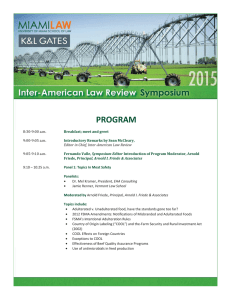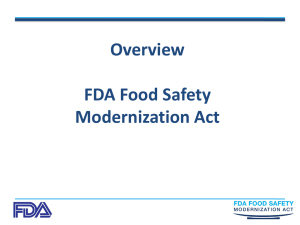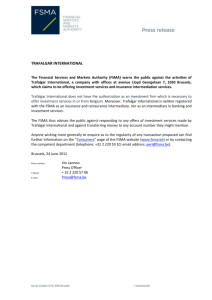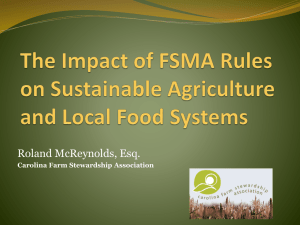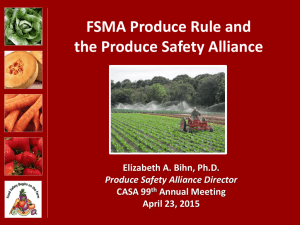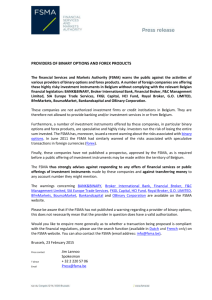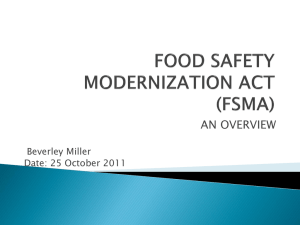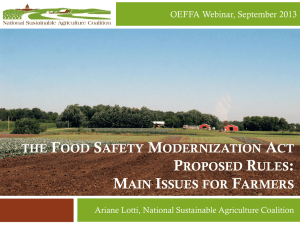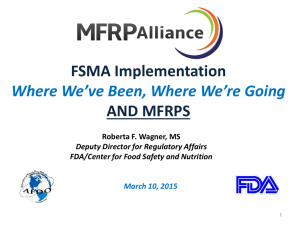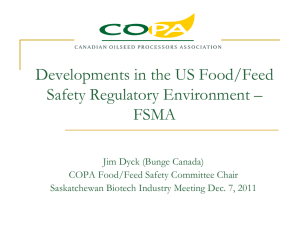Good Agricultural Practices - Western Colorado Food and Farm Forum
advertisement
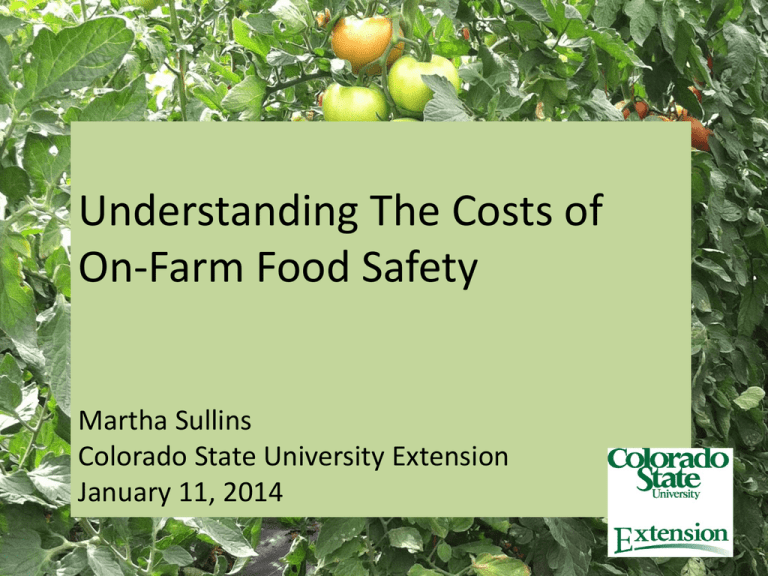
Understanding The Costs of On-Farm Food Safety Martha Sullins Colorado State University Extension January 11, 2014 Overview • What are the key policy and economic drivers impacting food safety today? • FSMA update • Role of Good Agricultural Practices • Estimated costs of good agricultural practices • Managing expenses AND keeping your produce safe Balancing public and individual health High levels of foodborne illness in the U.S. Most recent estimates: • 48 million cases per year – One out of every six of us • 128,000 hospitalizations • 3,000 deaths • Not all persons are at equal risk of contracting a foodborne illness – some have higher risk – pregnant women (& fetus), seniors, young children, compromised immune system Source: Scallan et al., 2011 The costs of food safety incidents to consumers and their communities Ohio State Researcher: Foodborne Illness Costs $77.7 Billion a Year Jan 17, 2012 Cost of food-borne illnesses is deemed much higher than earlier estimates A report sponsored by the Produce Safety Project at Georgetown University puts the health-related price tag at $152 billion a year. That's more than four times an earlier USDA estimate. March 03, 2010|By Andrew Zajac and P.J. Huffstutter COLUMBUS, Ohio -- The cost of foodborne illness in the United States is now estimated to be up to $77.7 billion a year, according to an analysis by Ohio State University researcher Robert Scharff. The industry says … “Produce is a target”* • 24-hr news cycles (TV, Internet & social media) have changed food safety forever… • Reports of lost consumer confidence abound Works against consumption Who is the most trusted spokesman? • Advocacy groups increasing • Food safety law is growing field • Brand protection = buyer requirements • Liability insurance needs impacting producer/buyer relationships? *From Produce Marketing Association Yet, we’re lagging in fruit and vegetable consumption • USDA Food Patterns (2010) recommend consuming 2.5 servings of vegetables and 2 servings of fruit per day. • CDC (2010) estimated only 26% consumed vegetables three or more times per day, and only 33% of adults consumed fruit two or more times per day. • CO Child Health Survey (2012) estimated 56% consumed less than 2 servings of vegetables per day and 50% consumed less than 2 servings of fruit per day. A look at federal government and produce grower responses to food safety issues What is FSMA? Food Safety Modernization Act • Reform of US food safety laws affecting domestically grown and imported foods (for human and animal foods), through 7 major rules, plus guidance, including: – Produce Safety (Standards for the Growing, Harvesting, Packing, and Holding of Produce for Human Consumption) – Preventive Controls (Current Good Manufacturing Practice and Hazard Analysis and Risk-Based Preventive Controls for Human Food) • FSMA was signed into law on January 4, 2011 List of all FSMA rules and guidance: http://www.fda.gov/Food/GuidanceRegulation/FSMA/ucm253380.htm For the produce industry, the proposed Produce Safety rule: • Means new standards for growing, harvesting, packing, and holding produce. • Applies to fruits and vegetables normally consumed raw (e.g., apples, carrots, lettuce, onions, tomatoes). • Does not apply to produce rarely consumed raw (e.g., kale, potatoes, winter squash) or grown for personal consumption. Proposed Produce Safety rule establishes standards for: • • • • • Agricultural water, Soil amendments (manure/compost), Animals (domesticated & wild), Workers’ health and hygiene, and Equipment and food contact surfaces Addresses the same 5 likely sources and vectors of fresh produce contamination in the field, during and post-harvest, as in the 1998 FDA GAPs Guide and most fresh produce guidance docs. Who does the Produce Safety rule apply to? • At this time, any farm that grows, harvests and distributes fruits and vegetables into commerce, with exemptions for: – Size of business (based on total sales ) – Percentage of direct sales to qualified end users Food sales include all products grown or raised for human or animal consumption or to be used as ingredients in any such item (i.e. produce that is a RAC), processed produce (non-RACs such as fresh-cut produce), animal-derived products such as milk and meat, aquaculture. How have the last 12 months influenced food safety policy? • FDA developed resources, held meetings and webinars to respond to industry concerns • 7-month comment period – Produce Safety Rule (18,547 comments rec’d) – Preventive Controls Rule (7,437 comments rec’d) Coalition of state ag directors, NSAC & United Fresh identified: • Added regulatory costs could reduce profits for existing farmers & prevent farm start-ups. • Reduced access to fresh local food, and regs discouraging on-farm value-added processing. • Diversifying income more difficult since more revenue would bring more regulation. • Costly water testing, including requirement that farmers test water from open sources every seven days. Farmer friendly? “Because of the input we received from farmers and the concerns they expressed about the impact of these rules on their lives and livelihood, we realized that significant changes must be made, while ensuring that the proposed rules remain consistent with our food safety goals." Michael Taylor, FDA What’s next? • Environmental impact statement still open for comment until March 15, 2014 • FDA is revising language on both rules, will open them for comment in early summer 2014 • In particular, FDA is revising: – water quality standards and water testing – standards for using raw manure and compost • Final rules must be published in the Federal Register by June 30, 2015 Final implementation • Two year implementation (2016 likely first year of enforcement) • Dates to be staggered for small (3 years) and very small (4 years) operations • Plus 2 years for some water requirements Science-based food safety practices What are GAPS? Good Agricultural Practices During Harvest During Production Before Planting PostHarvest GAPs • Practices used during crop production, harvesting, and packing to minimize the contamination of fruits and vegetables from human pathogens. • Focus on the fundamentals of: ‒ Safe Soil ‒ Clean Water ‒ Clean Surfaces ‒ Clean Hands How much do fruit and vegetable producers invest in food safety? In this study, CSU wanted to understand… • The costs of GAPs for worker training, recordkeeping, monitoring, testing, cleaning and sanitizing activities to produce and sell produce with the lowest risk of microbial contamination Collecting data to understand current costs that growers face This will allow us to: 1. Help growers better incorporate food safety into their financial planning 2. Provide feedback to FDA on the impact of FSMA in Colorado, to different sizes of fruit and vegetable operations 3. Project increased costs under FSMA Wide range of on-farm food safety costs • Labor force: – New hires to manage food safety program or practices? – New tasks for existing workers? • Worker hygiene: – Training – Sanitation supplies • Facility improvements & upkeep – Restrooms, hand-washing stations – Drinking water stations Costs of ensuring safe inputs Testing: – Production and post-harvest water – Soil & soil amendments Monitoring: – Supplies for temperature control Management: – Sanitizing post-harvest water – Fencing, deterring wildlife & pets, berms, irrigation system modifications Expenses related to facilities, tools & equipment • • • • Rodent control Cleaning supplies New tools, equipment & packaging New or improved facilities: – Construction of new wash stations, coolers, storage areas – Upkeep on buildings, equipment Recordkeeping, marketing communication, other costs • • • • • Signage, labeling, packaging Traceabililty Web site improvements, software Audits Insurance So far, growers from 13 counties have responded • Most are growing diverse crops that will fall under FSMA • By size of farm: >100 acres 30% (9 farms) 10-100 acres 13% (4 farms) <10 acres 57% (17 farms) Farm profile • By annual sales: >$500,000 (17%) $250,000$500,000 (40%) Under $25,000 (30%) $25,000$249,999 (13%) • 40% have livestock operations also • 67% are open to the public Most report having a food safety plan Working on it now (33%) No plan (3%) Yes (60%) Most growers use GAPs, as well as other food safety practices 80% 70% 60% 50% 40% 30% 20% 10% 0% More than half have conducted an audit themselves, but have not used outside auditor • Self-audit in 2013=60% • Third-party audits: 53% have not conducted one, but other growers have: 25% 20% 15% 10% 5% 0% Labor impacts of food safety • A few growers hired new staff (20%) 2012 2013 Managers 20% 10% Paid labor 7% 3% Volunteers, interns 0% 0% But many conducted annual worker training in 2013 • 80% trained managers at $388 per manager • 57% conducted worker/field labor training at $31 per worker • 20% trained volunteers at value of $40 per volunteer Training costs depend on scale of operation and practices Average number trained Managers Field workers >100 acres 5 162 10 - 100 acres 2 31 <10 acres 1 5 Hidden or unanticipated costs: labor 1. Labor costs (management) 2. Labor costs (nonmanagement) • Employee training (delivery & participation) • Recordkeeping • Hygiene • Post-harvest food safety • Cleaning food contact surfaces • Vehicle inspection and cleaning • Mock audit What do growers report as their yearly costs of GAPs? (Average expenses per acre, all farms) Additional time spent on food safety practices $ 1,292 Employee training $ 248 Improvements (coolers, restrooms, fencing) $ 614 Supplies (paper towels, gloves, sanitizers) $ Audits, packaging, consumer info. at market $ 267 Annual expenses for improvements $ 202 Water & soil testing $ Average total expenses on food safety $ 2,942 296 24 Average annual per acre costs for supplies ($296) Containers, packaging $ 167 Handwashing & hygiene supplies $ 39 Office supplies for traceability, documentation $ 34 Rodent control supplies $ 24 Sanitizers for post harvest water $ 12 Cleaning supplies & sanitizers for tools, etc. $ 10 Temperature control supplies $ 9 One-time investments, average annual per acre costs ($614) Fencing, wildlife deterrents $ 331 Coolers, insulation Post-harvest handling (wash stations, sanitation equip) Production water-source, delivery, drainage changes Hygiene improvements (restrooms, handwashing) $ 96 Processing & packing costs $ 27 Harvest tools & equipment $ 26 Signage on safety, visitor & worker policies <$ 1 $ 48 $ 42 $ 33 Examples of unanticipated or overlooked costs • First aid kits, drinking water stations in the field • New electrical wiring to support walk-in cooler or other refrigeration • Software to track employee training, payroll • All new packaging required by produce buyer Keeping your costs under control 1. Assess your food safety risks, based on your production inputs, managerial capability, workforce, adjacent land uses & activities, water sources 2. Use estimated costs as a budgeting guideline 3. Follow critical practices Critical practices that will help avoid or reduce additional costs • Document, document, document – Keep track of your practices – Keep track of your costs • Test water regularly • Keep work areas clean • Train workers regularly on hygiene & sanitation practices • Check cooler temperatures daily • Sanitize all tools and harvest containers often • Use well-composted manure • Keep animals out of crop production areas Save the Date! Tools for Improving Food Safety on Your Farm March 12, 2014 Montrose County Fairgrounds Topics covered: • Assessing worker practices & developing a training program for your workforce • How and when to take water samples, how to read water test results, & developing a management plan based on test results • Developing and implementing cleaning and sanitizing procedures for tools and equipment • Developing a product traceability, recall and communication plan for diverse supply chains Resources - Basics of GAPs Good Agricultural Practices webinars • Part 1: Food Safety Basics, Regulatory Landscape, 3rd Party Audits, Worker Hygiene Available from: https://connect.extension.iastate.edu/p97225744/Webi nar 1 Slides • Part 2: Minimizing Risks During Production: Irrigation Water and Manure Management Available from: https://connect.extension.iastate.edu/p26083829/ Webinar 2 Slides • Part 3: Minimizing Risks During Harvest & Post-Harvest: Washing & Packing, Cooling & Storage, Transportation & Traceback Available from: Webinar 3 Slides Resources - Creating a Plan • Fundamentals of Creating a Colorado Farm Food Safety Plan Webinar: Webinar: https://connect.extension.iastate.edu/p4b9anz 5nu9/ • Colorado Farm Plan Guide: http://www.farmtotable.colostate.edu/growfiles/ColoradoFoodSafetyPlanGuide.pdf • Colorado Farm Plan Template: http://www.farmtotable.colostate.edu/growfiles/2012-ColoradoFarmPlanFillableForm.pdf More Resources • Global GAP: http://www.globalgap.org/uk_en/forproducers/crops/ • Harmonized GAP: http://www.ams.usda.gov/AMSv1.0/HarmonizedGAP • CSU Extension food safety web site: www.farmtotable.colostate.edu • Food safety & direct marketing regs: www.cofarmtomarket.com • http://www.foodsafetynews.com/ • http://www.fda.gov/Food/FoodSafety/FSMA/default.htm • FSMA Updates to subscribe to email updates from FDA Questions or for more information, Martha Sullins Colorado State University Extension martha.sullins@colostate.edu 970-498-6006
